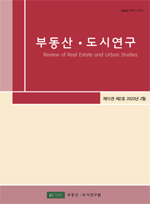본 연구의 목적은 경기도 공공택지개발사업 내 입찰대상토지인 상업시설 등의 낙찰가율에 미치는 영향에 대해경기 남부와 북부를 비교ㆍ분석하는 데 있다. 연구의 시간적 범위는 2016년부터 2018년까지이며, 공간적 범위는 한국토지공사 및 경기도시공사가 일반 실수요자들에게 공급하여 낙찰된 경기지역의 상업시설, 근린생활시설 용지 대상으로 한다. 연구를 위해 경기 남부지역은255필지, 경기 북부지역 138필지 총 393필지에 대한 데이터를 확보하고, 다중회귀분석을 위하여 데이터 형태를 가공하여 사용했다. 변수는 경기 남부와 북부지역의 공공택지개발사업지구에 공급한 상업용지의 낙찰가율을 종속변수로 하여 독립변수는 연도, 획지, 접근, 환경요인으로 구분하여 선정하였다. 본 연구는 경기 남부와 북부지역을 구분하여 낙찰가율을 비교한 것과 공급 필지의 개별적 요인뿐만 지구와 서울주요 도심과의 거리 등의 지역적 환경 변수를 추가하여 비교했다는 점에서 선행 논문과 차별점이라 할 수 있다. 분석 결과는 경기도 3기 신도시 5곳을 지구 지정 완료하여 지구계획 수립 중인 시점에서 신규 공공택지개발사업 내입찰대상토지의 공급가격 결정과 실수요자들의 입찰가격 결정에 유익한 기준으로 활용할 수 있다는 점에서 시사점을 둔다.
The purpose of this study is to compare and analyze the successful bid price rate of commercial facility sites in public land development projects for housing supply between southern and northern regions of Gyeonggi-do. The data are 255 lots in the southern region and 138 lots in the northern region for commercial land. Multiple regression analysis is conducted. The analysis result shows that there are distinguishing points such as floor area ratio, distance to main city center of seoul or subway station between both regions. The result of analysis show that the land, access, environmental factors that affect the winning price rate of commercial facility sites in public land development projects vary depending on the southern and northern regions of Gyeonggi-do. The southern region is most affected by the number of households in the district and The northern region is most affected by floor area ratio. In addition, the closest of distance from seoul's main city center affect both areas, but its direction appears to be reversed The implications could be used as a useful criterion for determining the price of the commercial land in new public land development projects for housing supply.
Ⅰ. 서론
Ⅱ. 이론적 고찰
Ⅲ. 분석의 틀
Ⅳ. 실증 분석
Ⅴ. 결론
참고문헌
